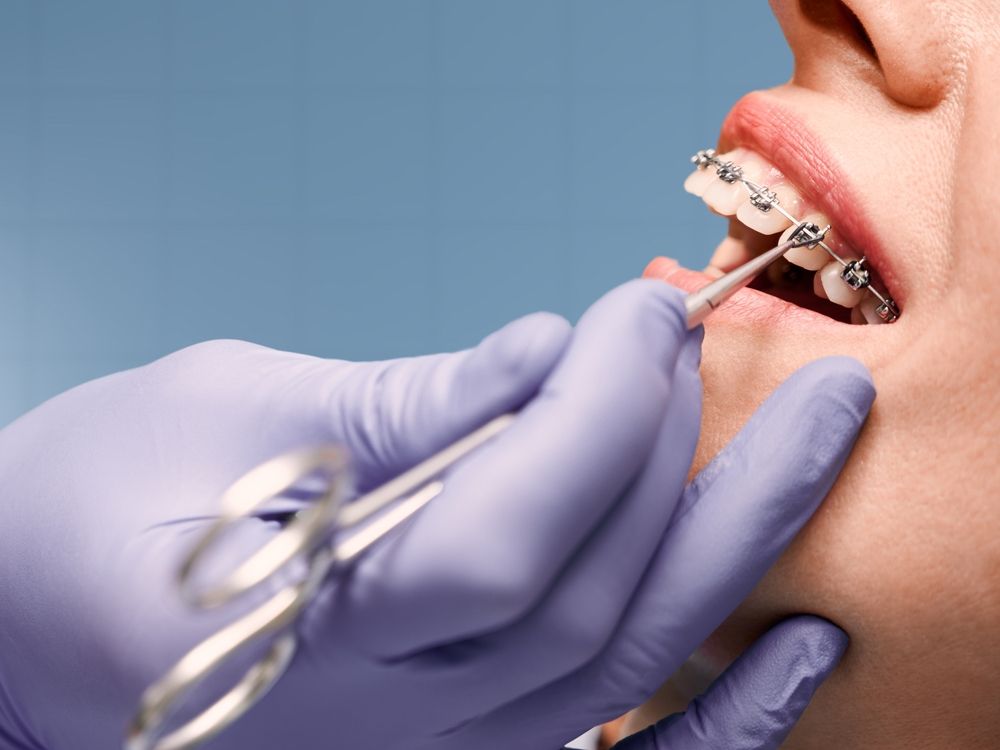Orthodontic treatment is a valuable investment in your smile, correcting misaligned teeth and improving oral function. However, wearing braces or clear aligners can make maintaining oral hygiene more challenging. Food can easily get trapped around brackets, wires, or aligner trays, increasing the risk of plaque buildup, tooth decay, and gum problems. Dental Touch Clinic, serving Oakville and surrounding areas, understands these challenges and provides useful guidance to help you care for your teeth throughout your orthodontic journey. With proper care, you can protect your teeth and enjoy the benefits of your treatment without unnecessary complications.
Understanding the Importance of Oral Hygiene with Braces or Aligners
When you begin orthodontic treatment, it’s essential to realize that your teeth require extra attention and care. Brackets and wires create more surfaces for bacteria and food debris to cling to, making regular brushing and flossing critical. Failure to maintain proper oral hygiene can lead to white spots (decalcification), cavities, or inflamed gums that can prolong treatment time or cause discomfort.
For those using clear aligners, the removable trays still require careful cleaning to prevent bacteria buildup that can cause bad breath or dental decay. Aligners must be cleaned thoroughly and regularly, and teeth should be brushed before reinserting the trays. Understanding these unique challenges is the first step to adapting your oral hygiene routine effectively during treatment.
Brushing Techniques and Tools for Orthodontic Patients
Brushing with braces or aligners requires both patience and the right tools. A soft-bristled toothbrush or an electric toothbrush with a small head can help clean around brackets and wires more effectively. It’s recommended to brush at least twice a day, and ideally after every meal, to remove trapped food particles and plaque.
When brushing, angle your toothbrush at a 45-degree angle to the gumline and carefully clean around brackets and wires using small circular motions. Don’t forget to brush all surfaces of each tooth, including the chewing surfaces and behind the teeth. For clear aligner users, brushing teeth and cleaning the trays with a soft brush and mild soap or specialized cleaning crystals can help prevent plaque buildup.
In addition to brushing, specialized interdental brushes or floss threaders can help clean between teeth and around orthodontic hardware. These tools are designed to navigate tight spaces and remove plaque where regular flossing might be difficult. Incorporating these into your routine enhances your oral care and protects your teeth during treatment.
Flossing and Additional Hygiene Tips
Flossing can be tricky with braces, but it remains a critical part of preventing gum disease and cavities. Traditional floss may be difficult to use around wires, but floss threaders and orthodontic floss picks make the process easier by guiding floss under the wires. Clear aligner wearers should floss regularly as well to maintain gum health and remove plaque.
Mouth rinses with fluoride can provide extra protection by strengthening enamel and reducing bacteria in the mouth. Talk to your dental provider about suitable rinses during orthodontic treatment. Avoid sugary or acidic beverages, which can increase the risk of decay around brackets or under aligners.
Maintaining regular visits with your orthodontist and dental hygienist is equally important. They can provide professional cleanings and monitor your oral health to address any issues early on. If you experience any discomfort or notice white spots or bleeding gums, contact your dental care provider promptly to avoid complications.
Managing Diet and Habits During Orthodontic Treatment
Diet plays a significant role in protecting your teeth while wearing braces or aligners. Sticky, hard, or chewy foods can damage brackets or wires and should be avoided. Common culprits include chewing gum, caramel, popcorn, nuts, and hard candies. Opting for softer foods and cutting fruits and vegetables into bite-sized pieces reduces the risk of damage.
For clear aligner users, it’s important to remove trays when eating or drinking anything other than water to prevent staining and bacterial buildup. Drinking plenty of water throughout the day helps rinse away food particles and keeps your mouth hydrated, promoting healthy saliva flow.
Additionally, habits such as nail-biting, chewing on pens, or grinding teeth can harm orthodontic appliances and slow treatment progress. Being mindful of these behaviors and seeking advice for teeth grinding or jaw clenching can protect both your teeth and your orthodontic work.
Staying Motivated for a Healthy Smile
Orthodontic treatment can take months or even years, making it easy to become lax with oral hygiene over time. However, maintaining motivation is essential to achieving the best results. Remember that the effort you put into caring for your teeth during treatment directly impacts the quality and longevity of your new smile.
Setting reminders to brush and floss, tracking your progress, and celebrating milestones can help maintain enthusiasm. Many patients find it helpful to keep their dental care kit handy at school, work, or home to make oral hygiene convenient and consistent.
By investing time and attention in your dental care throughout orthodontic treatment, you’re not only protecting your teeth but also supporting the success of your orthodontic journey and the beautiful smile that awaits you at the end.
Resources
- Proffit, W. R., Fields, H. W., & Sarver, D. M. (2013). Contemporary Orthodontics. Elsevier Health Sciences.
- American Association of Orthodontists. (2020). Orthodontic Oral Hygiene Tips.
- Boyd, R. L., & Baumrind, S. (1992). The effect of different toothbrushing methods on plaque and gingivitis. Journal of Clinical Periodontology.

